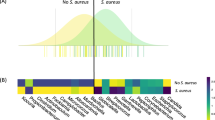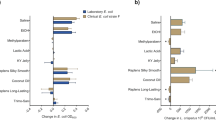Abstract
Tampons are associated with toxic shock syndrome (mTSS). One reason for this association is oxygen introduction within tampons into the anaerobic vagina. Oxygen is required for Staphylococcus aureus to produce TSS toxin-1 (TSST-1). There have been changes in use of medical devices to control menstrual flow, including increased use of menstrual discs and cups. These devices composed of solid, flexible materials do not absorb menstrual fluid and thus do not trap oxygen. This study evaluates tampons and non-absorbent devices for effect on S. aureus and TSST-1 production. There are three in vitro tests to evaluate devices for effect on TSST-1 production: (1) stationary flask, (2) shake flask, and (3) tampon sac. In this study, 100% rayon and 100% cotton tampons with three absorbencies, contraceptive diaphragms, and menstrual discs and cups were tested for effect on S. aureus growth and TSST-1 production. Product composition did not affect bacterial growth or TSST-1 production. Tampons showed no effect on S. aureus growth compared with no-tampon controls, but tampons showed enhanced TSST-1 production as a function of trapped oxygen in stationary cultures and tampon sacs but not in shake flasks. The non-absorbent devices showed no enhanced S. aureus growth or TSST-1 production compared with no-device controls. These studies are consistent with the association of tampons with mTSS as a function of absorbency, but they suggest the occasional association of mTSS with non-absorbent devices may be coincidental as opposed to co-causative.





Similar content being viewed by others
Data availability
Original data will be made available upon request.
References
Shands KN, Schmid GP, Dan BB, Blum D, Guidotti RJ, Hargrett NT, Anderson RL, Hill DL, Broome CV, Band JD et al (1980) Toxic-shock syndrome in menstruating women: association with tampon use and Staphylococcus aureus and clinical features in 52 cases. N Engl J Med 303(25):1436–1442
Davis JP, Chesney PJ, Wand PJ, LaVenture M (1980) The investigation and laboratory team. Toxic shock syndrome: epidemiological features, recurrence, risk factors, and prevention. N Engl J Med 303(25):1429–1435
Schlievert PM, Shands KN, Dan BB, Schmid GP, Nishimura RD (1981) Identification and characterization of an exotoxin from Staphylococcus aureus associated with toxic-shock syndrome. J Infect Dis 143(4):509–516
Kreiswirth BN, Lofdahl S, Betley MJ, O’Reilly M, Schlievert PM, Bergdoll MS, Novick RP (1983) The toxic shock syndrome exotoxin structural gene is not detectably transmitted by a prophage. Nature 305(5936):709–712
Reingold AL, Hargrett NT, Shands KN, Dan BB, Schmid GP, Strickland BY, Broome CV (1982) Toxic shock syndrome surveillance in the United States, 1980 to 1981. Ann Intern Med 96(6 Pt 2):875–880
Davis JP, Chesney PJ, Wand PJ, LaVenture M (1980) Toxic-shock syndrome: epidemiologic features, recurrence, risk factors, and prevention. N Engl J Med 303(25):1429–1435
Davis JP, Osterholm MT, Helms CM, Vergeront JM, Wintermeyer LA, Forfang JC, Judy LA, Rondeau J, Schell WL (1982) Tri-state toxic-shock syndrome study. II. Clinical and laboratory findings. J Infect Dis 145(4):441–448
Osterholm MT, Davis JP, Gibson RW, Mandel JS, Wintermeyer LA, Helms CM, Forfang JC, Rondeau J, Vergeront JM (1982) Tri-state toxic-state syndrome study. I. Epidemiologic findings. J Infect Dis 145(4):431–440
Mills JT, Parsonnet J, Kass EH (1986) Production of toxic-shock-syndrome toxin-1: effect of magnesium ion. J Infect Dis 153(5):993–994
Broome CV, Hayes PS, Ajello GW, Feeley JC, Gibson RJ, Graves LM, Hancock GA, Anderson RL, Highsmith AK, Mackel DC et al (1982) In-vitro studies of interactions between tampons and Staphylococcus aureus. Ann Intern Med 96(6 Pt 2):959–962
Tierno PM Jr, Hanna BA (1985) In vitro amplification of toxic shock syndrome toxin-1 by intravaginal devices. Contraception 31(2):185–194
Tierno PM Jr, Hanna BA (1986) Magnesium and the production of toxic-shock-syndrome toxin-1 by Staphylococcus aureus. J Infect Dis 153(5):994–996
Tierno PM Jr, Hanna BA (1998) Viscose rayon versus cotton tampons. J Infect Dis 177(3):824–826
Tierno PM, Hanna BA (1983) Enzymic hydrolysis of tampon carboxymethylcellulose and toxic shock syndrome. Lancet 1(8338):1379–1380
Schlievert PM, Blomster DA (1983) Production of staphylococcal pyrogenic exotoxin type C: influence of physical and chemical factors. J Infect Dis 147(2):236–242
Pragman AA, Yarwood JM, Tripp TJ, Schlievert PM (2004) Characterization of virulence factor regulation by SrrAB, a two-component system in Staphylococcus aureus. J Bacteriol 186(8):2430–2438
Yarwood JM, McCormick JK, Schlievert PM (2001) Identification of a novel two-component regulatory system that acts in global regulation of virulence factors of Staphylococcus aureus. J Bacteriol 183(4):1113–1123
Yarwood JM, Schlievert PM (2000) Oxygen and carbon dioxide regulation of toxic shock syndrome toxin 1 production by Staphylococcus aureus MN8. J Clin Microbiol 38(5):1797–1803
Parsonnet J, Modern PA, Giacobbe KD (1996) Effect of tampon composition on production of toxic shock syndrome toxin-1 by Staphylococcus aureus in vitro. J Infect Dis 173(1):98–103
Fischetti VA, Chapman F, Kakani R, James J, Grun E, Zabriskie JB (1989) Role of air in growth and production of toxic shock syndrome toxin 1 by Staphylococcus aureus in experimental cotton and rayon tampons. Rev Infect Dis 11(Suppl 1):S176–S181
Reingold AL (1986) Toxic shock syndrome and the contraceptive sponge. Jama 255(2):242–243
Reingold AL, Broome CV, Gaventa S, Hightower AW (1989) Risk factors for menstrual toxic shock syndrome: results of a multistate case-control study. Rev Infect Dis 11(Suppl 1):S35–S41 discussion S41–32
Nonfoux L, Chiaruzzi M, Badiou C, Baude J, Tristan A, Thioulouse J, Muller D, Prigent Combaret C, Lina G (2018) Impact of currently marketed tampons and menstrual cups on Staphylococcus aureus growth and TSST-1 production in vitro. Appl Environ Microbiol(84):e00351-18
Hill DR, Brunner ME, Schmitz DC, Davis CC, Flood JA, Schlievert PM, Wang-Weigand SZ, Osborn TW (2005) In vivo assessment of human vaginal oxygen and carbon dioxide levels during and post menses. J Appl Physiol (1985) 99(4):1582–1591
Schlievert PM, Kelly JA (1984) Clindamycin-induced suppression of toxic-shock syndrome--associated exotoxin production. J Infect Dis 149(3):471
Schlievert PM, Blomster DA, Kelly JA (1984) Toxic shock syndrome Staphylococcus aureus: effect of tampons on toxic shock syndrome toxin 1 production. Obstet Gynecol 64(5):666–671
Lee AC, Crass BA, Bergdoll MS (1987) Investigation by syringe method of effect of tampons on production in vitro of toxic shock syndrome toxin 1 by Staphylococcus aureus. J Clin Microbiol 25(1):87–90
O’Reilly M, Kreiswirth B, Foster TJ (1990) Cryptic alpha-toxin gene in toxic shock syndrome and septicaemia strains of Staphylococcus aureus. Mol Microbiol 4(11):1947–1955
Schlievert PM, Strandberg KL, Lin YC, Peterson ML, Leung DY (2010) Secreted virulence factor comparison between methicillin-resistant and methicillin-sensitive Staphylococcus aureus, and its relevance to atopic dermatitis. J Allergy Clin Immunol 125(1):39–49
Schlievert PM, Peterson ML (2012) Glycerol monolaurate antibacterial activity in broth and biofilm cultures. PLoS One 7(7):e40350
Schlievert PM, Nemeth KA, Davis CC, Peterson ML, Jones BE (2010) Staphylococcus aureus exotoxins are present in vivo in tampons. Clin Vaccine Immunol 17(5):722–727
Schlievert PM, Case LC, Strandberg KL, Tripp TJ, Lin YC, Peterson ML (2007) Vaginal Staphylococcus aureus superantigen profile shift from 1980 and 1981 to 2003, 2004, and 2005. J Clin Microbiol 45(8):2704–2707
Schlievert PM, Tripp TJ, Peterson ML (2004) Reemergence of staphylococcal toxic shock syndrome in Minneapolis-St. Paul, Minnesota, during the 2000-2003 surveillance period. J Clin Microbiol 42(6):2875–2876
Schlievert PM (1995) Comparison of cotton and cotton/rayon tampons for effect on production of toxic shock syndrome toxin. J Infect Dis 172(4):1112–1114
Funding
This research was funded through a grant from the University of Iowa, Carver College of Medicine.
Author information
Authors and Affiliations
Corresponding author
Ethics declarations
Conflict of interest
The author declares that he has no conflict of interest.
Additional information
Publisher's note
Springer Nature remains neutral with regard to jurisdictional claims in published maps and institutional affiliations.
Rights and permissions
About this article
Cite this article
Schlievert, P.M. Effect of non-absorbent intravaginal menstrual/contraceptive products on Staphylococcus aureus and production of the superantigen TSST-1. Eur J Clin Microbiol Infect Dis 39, 31–38 (2020). https://doi.org/10.1007/s10096-019-03685-x
Received:
Accepted:
Published:
Issue Date:
DOI: https://doi.org/10.1007/s10096-019-03685-x




